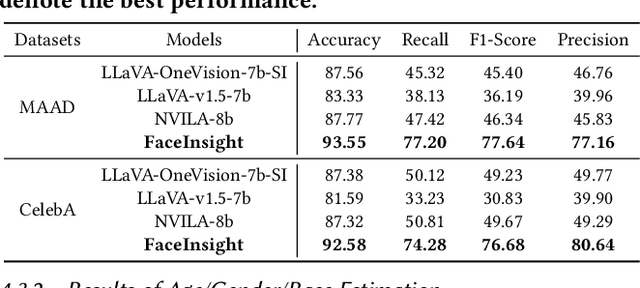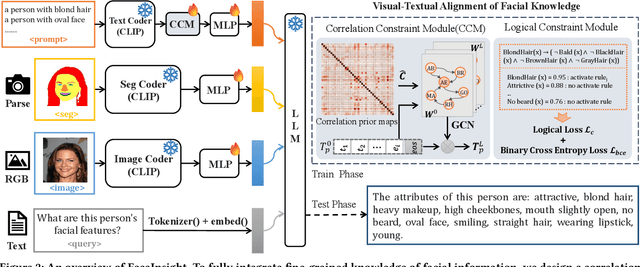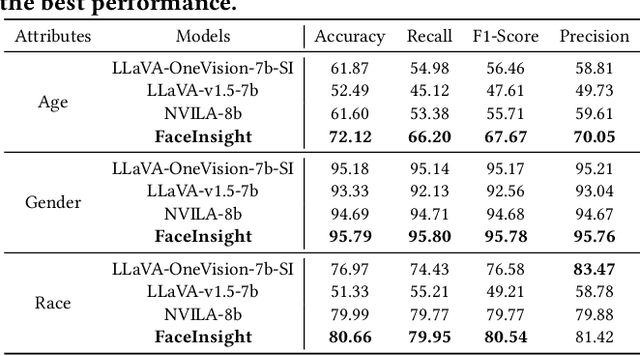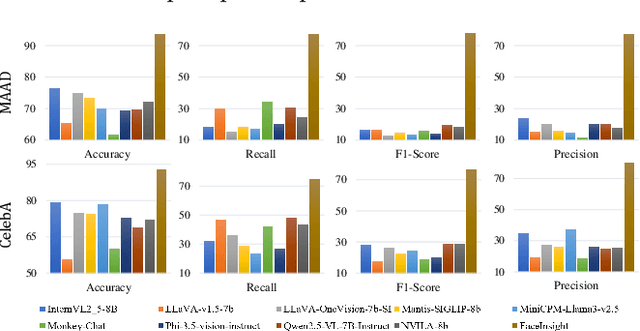Hua Zhang
Where MLLMs Attend and What They Rely On: Explaining Autoregressive Token Generation
Sep 26, 2025Abstract:Multimodal large language models (MLLMs) have demonstrated remarkable capabilities in aligning visual inputs with natural language outputs. Yet, the extent to which generated tokens depend on visual modalities remains poorly understood, limiting interpretability and reliability. In this work, we present EAGLE, a lightweight black-box framework for explaining autoregressive token generation in MLLMs. EAGLE attributes any selected tokens to compact perceptual regions while quantifying the relative influence of language priors and perceptual evidence. The framework introduces an objective function that unifies sufficiency (insight score) and indispensability (necessity score), optimized via greedy search over sparsified image regions for faithful and efficient attribution. Beyond spatial attribution, EAGLE performs modality-aware analysis that disentangles what tokens rely on, providing fine-grained interpretability of model decisions. Extensive experiments across open-source MLLMs show that EAGLE consistently outperforms existing methods in faithfulness, localization, and hallucination diagnosis, while requiring substantially less GPU memory. These results highlight its effectiveness and practicality for advancing the interpretability of MLLMs. The code is available at https://github.com/RuoyuChen10/EAGLE.
The Emotional Baby Is Truly Deadly: Does your Multimodal Large Reasoning Model Have Emotional Flattery towards Humans?
Aug 06, 2025Abstract:We observe that MLRMs oriented toward human-centric service are highly susceptible to user emotional cues during the deep-thinking stage, often overriding safety protocols or built-in safety checks under high emotional intensity. Inspired by this key insight, we propose EmoAgent, an autonomous adversarial emotion-agent framework that orchestrates exaggerated affective prompts to hijack reasoning pathways. Even when visual risks are correctly identified, models can still produce harmful completions through emotional misalignment. We further identify persistent high-risk failure modes in transparent deep-thinking scenarios, such as MLRMs generating harmful reasoning masked behind seemingly safe responses. These failures expose misalignments between internal inference and surface-level behavior, eluding existing content-based safeguards. To quantify these risks, we introduce three metrics: (1) Risk-Reasoning Stealth Score (RRSS) for harmful reasoning beneath benign outputs; (2) Risk-Visual Neglect Rate (RVNR) for unsafe completions despite visual risk recognition; and (3) Refusal Attitude Inconsistency (RAIC) for evaluating refusal unstability under prompt variants. Extensive experiments on advanced MLRMs demonstrate the effectiveness of EmoAgent and reveal deeper emotional cognitive misalignments in model safety behavior.
SComCP: Task-Oriented Semantic Communication for Collaborative Perception
Jul 01, 2025Abstract:Reliable detection of surrounding objects is critical for the safe operation of connected automated vehicles (CAVs). However, inherent limitations such as the restricted perception range and occlusion effects compromise the reliability of single-vehicle perception systems in complex traffic environments. Collaborative perception has emerged as a promising approach by fusing sensor data from surrounding CAVs with diverse viewpoints, thereby improving environmental awareness. Although collaborative perception holds great promise, its performance is bottlenecked by wireless communication constraints, as unreliable and bandwidth-limited channels hinder the transmission of sensor data necessary for real-time perception. To address these challenges, this paper proposes SComCP, a novel task-oriented semantic communication framework for collaborative perception. Specifically, SComCP integrates an importance-aware feature selection network that selects and transmits semantic features most relevant to the perception task, significantly reducing communication overhead without sacrificing accuracy. Furthermore, we design a semantic codec network based on a joint source and channel coding (JSCC) architecture, which enables bidirectional transformation between semantic features and noise-tolerant channel symbols, thereby ensuring stable perception under adverse wireless conditions. Extensive experiments demonstrate the effectiveness of the proposed framework. In particular, compared to existing approaches, SComCP can maintain superior perception performance across various channel conditions, especially in low signal-to-noise ratio (SNR) scenarios. In addition, SComCP exhibits strong generalization capability, enabling the framework to maintain high performance across diverse channel conditions, even when trained with a specific channel model.
3D Scene-Camera Representation with Joint Camera Photometric Optimization
Jun 26, 2025Abstract:Representing scenes from multi-view images is a crucial task in computer vision with extensive applications. However, inherent photometric distortions in the camera imaging can significantly degrade image quality. Without accounting for these distortions, the 3D scene representation may inadvertently incorporate erroneous information unrelated to the scene, diminishing the quality of the representation. In this paper, we propose a novel 3D scene-camera representation with joint camera photometric optimization. By introducing internal and external photometric model, we propose a full photometric model and corresponding camera representation. Based on simultaneously optimizing the parameters of the camera representation, the proposed method effectively separates scene-unrelated information from the 3D scene representation. Additionally, during the optimization of the photometric parameters, we introduce a depth regularization to prevent the 3D scene representation from fitting scene-unrelated information. By incorporating the camera model as part of the mapping process, the proposed method constructs a complete map that includes both the scene radiance field and the camera photometric model. Experimental results demonstrate that the proposed method can achieve high-quality 3D scene representations, even under conditions of imaging degradation, such as vignetting and dirt.
Unpacking Positional Encoding in Transformers: A Spectral Analysis of Content-Position Coupling
May 19, 2025Abstract:Positional encoding (PE) is essential for enabling Transformers to model sequential structure. However, the mechanisms by which different PE schemes couple token content and positional information-and how these mechanisms influence model dynamics-remain theoretically underexplored. In this work, we present a unified framework that analyzes PE through the spectral properties of Toeplitz and related matrices derived from attention logits. We show that multiplicative content-position coupling-exemplified by Rotary Positional Encoding (RoPE) via a Hadamard product with a Toeplitz matrix-induces spectral contraction, which theoretically improves optimization stability and efficiency. Guided by this theory, we construct synthetic tasks that contrast content-position dependent and content-position independent settings, and evaluate a range of PE methods. Our experiments reveal strong alignment with theory: RoPE consistently outperforms other methods on position-sensitive tasks and induces "single-head deposit" patterns in early layers, indicating localized positional processing. Further analyses show that modifying the method and timing of PE coupling, such as MLA in Deepseek-V3, can effectively mitigate this concentration. These results establish explicit content-relative mixing with relative-position Toeplitz signals as a key principle for effective PE design and provide new insight into how positional structure is integrated in Transformer architectures.
Photovoltaic Defect Image Generator with Boundary Alignment Smoothing Constraint for Domain Shift Mitigation
May 09, 2025Abstract:Accurate defect detection of photovoltaic (PV) cells is critical for ensuring quality and efficiency in intelligent PV manufacturing systems. However, the scarcity of rich defect data poses substantial challenges for effective model training. While existing methods have explored generative models to augment datasets, they often suffer from instability, limited diversity, and domain shifts. To address these issues, we propose PDIG, a Photovoltaic Defect Image Generator based on Stable Diffusion (SD). PDIG leverages the strong priors learned from large-scale datasets to enhance generation quality under limited data. Specifically, we introduce a Semantic Concept Embedding (SCE) module that incorporates text-conditioned priors to capture the relational concepts between defect types and their appearances. To further enrich the domain distribution, we design a Lightweight Industrial Style Adaptor (LISA), which injects industrial defect characteristics into the SD model through cross-disentangled attention. At inference, we propose a Text-Image Dual-Space Constraints (TIDSC) module, enforcing the quality of generated images via positional consistency and spatial smoothing alignment. Extensive experiments demonstrate that PDIG achieves superior realism and diversity compared to state-of-the-art methods. Specifically, our approach improves Frechet Inception Distance (FID) by 19.16 points over the second-best method and significantly enhances the performance of downstream defect detection tasks.
FaceInsight: A Multimodal Large Language Model for Face Perception
Apr 22, 2025



Abstract:Recent advances in multimodal large language models (MLLMs) have demonstrated strong capabilities in understanding general visual content. However, these general-domain MLLMs perform poorly in face perception tasks, often producing inaccurate or misleading responses to face-specific queries. To address this gap, we propose FaceInsight, the versatile face perception MLLM that provides fine-grained facial information. Our approach introduces visual-textual alignment of facial knowledge to model both uncertain dependencies and deterministic relationships among facial information, mitigating the limitations of language-driven reasoning. Additionally, we incorporate face segmentation maps as an auxiliary perceptual modality, enriching the visual input with localized structural cues to enhance semantic understanding. Comprehensive experiments and analyses across three face perception tasks demonstrate that FaceInsight consistently outperforms nine compared MLLMs under both training-free and fine-tuned settings.
Generalized Semantic Contrastive Learning via Embedding Side Information for Few-Shot Object Detection
Apr 09, 2025Abstract:The objective of few-shot object detection (FSOD) is to detect novel objects with few training samples. The core challenge of this task is how to construct a generalized feature space for novel categories with limited data on the basis of the base category space, which could adapt the learned detection model to unknown scenarios. However, limited by insufficient samples for novel categories, two issues still exist: (1) the features of the novel category are easily implicitly represented by the features of the base category, leading to inseparable classifier boundaries, (2) novel categories with fewer data are not enough to fully represent the distribution, where the model fine-tuning is prone to overfitting. To address these issues, we introduce the side information to alleviate the negative influences derived from the feature space and sample viewpoints and formulate a novel generalized feature representation learning method for FSOD. Specifically, we first utilize embedding side information to construct a knowledge matrix to quantify the semantic relationship between the base and novel categories. Then, to strengthen the discrimination between semantically similar categories, we further develop contextual semantic supervised contrastive learning which embeds side information. Furthermore, to prevent overfitting problems caused by sparse samples, a side-information guided region-aware masked module is introduced to augment the diversity of samples, which finds and abandons biased information that discriminates between similar categories via counterfactual explanation, and refines the discriminative representation space further. Extensive experiments using ResNet and ViT backbones on PASCAL VOC, MS COCO, LVIS V1, FSOD-1K, and FSVOD-500 benchmarks demonstrate that our model outperforms the previous state-of-the-art methods, significantly improving the ability of FSOD in most shots/splits.
Beyond Progress Measures: Theoretical Insights into the Mechanism of Grokking
Apr 04, 2025Abstract:Grokking, referring to the abrupt improvement in test accuracy after extended overfitting, offers valuable insights into the mechanisms of model generalization. Existing researches based on progress measures imply that grokking relies on understanding the optimization dynamics when the loss function is dominated solely by the weight decay term. However, we find that this optimization merely leads to token uniformity, which is not a sufficient condition for grokking. In this work, we investigate the grokking mechanism underlying the Transformer in the task of prime number operations. Based on theoretical analysis and experimental validation, we present the following insights: (i) The weight decay term encourages uniformity across all tokens in the embedding space when it is minimized. (ii) The occurrence of grokking is jointly determined by the uniformity of the embedding space and the distribution of the training dataset. Building on these insights, we provide a unified perspective for understanding various previously proposed progress measures and introduce a novel, concise, and effective progress measure that could trace the changes in test loss more accurately. Finally, to demonstrate the versatility of our theoretical framework, we design a dedicated dataset to validate our theory on ResNet-18, successfully showcasing the occurrence of grokking.
Less is More: Efficient Black-box Attribution via Minimal Interpretable Subset Selection
Apr 01, 2025Abstract:To develop a trustworthy AI system, which aim to identify the input regions that most influence the models decisions. The primary task of existing attribution methods lies in efficiently and accurately identifying the relationships among input-prediction interactions. Particularly when the input data is discrete, such as images, analyzing the relationship between inputs and outputs poses a significant challenge due to the combinatorial explosion. In this paper, we propose a novel and efficient black-box attribution mechanism, LiMA (Less input is More faithful for Attribution), which reformulates the attribution of important regions as an optimization problem for submodular subset selection. First, to accurately assess interactions, we design a submodular function that quantifies subset importance and effectively captures their impact on decision outcomes. Then, efficiently ranking input sub-regions by their importance for attribution, we improve optimization efficiency through a novel bidirectional greedy search algorithm. LiMA identifies both the most and least important samples while ensuring an optimal attribution boundary that minimizes errors. Extensive experiments on eight foundation models demonstrate that our method provides faithful interpretations with fewer regions and exhibits strong generalization, shows an average improvement of 36.3% in Insertion and 39.6% in Deletion. Our method also outperforms the naive greedy search in attribution efficiency, being 1.6 times faster. Furthermore, when explaining the reasons behind model prediction errors, the average highest confidence achieved by our method is, on average, 86.1% higher than that of state-of-the-art attribution algorithms. The code is available at https://github.com/RuoyuChen10/LIMA.
 Add to Chrome
Add to Chrome Add to Firefox
Add to Firefox Add to Edge
Add to Edge